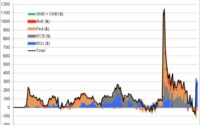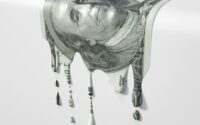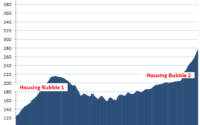How will the US Federal Reserve respond to stagflation?
March was supposed to be the month that the US Federal Reserve raised interest-rates by 0.5%. or at least so we were told. On the way to a series of rises with some predicting nine of them. But much has changed and we have not even reached the Ides of March yet. This is in spite of the fact that the reason for it has kept going.
The PCE price index for January increased 6.1 percent from one year ago, reflecting increases in both goods and services (table 11). Energy prices increased 25.9 percent while food prices increased 6.7 percent. Excluding food and energy, the PCE price index for January increased 5.2 percent from one year ago.
This is well above the inflation target even the new one as reflected upon by Chair Powell at Congress yesterday.
Inflation increased sharply last year and is now running well above our longer-run objective of 2 percent. Demand is strong, and bottlenecks and supply constraints are limiting how quickly production can respond. These supply disruptions have been larger and longer lasting than anticipated, exacerbated by waves of the virus, and price increases are now spreading to a broader range of goods and services.
It is interesting how his Transitory claims have morphed into a “longer lasting than anticipated” as those who were predicting it like me get dismissed as if they did not exist. A classic establishment tactic.
Regular will note quite a shift in the next sentence from him.
We understand that high inflation imposes significant hardship, especially on those least able to meet the higher costs of essentials like food, housing, and transportation.
Food and transportation ( via energy costs) are usually dismissed as non-core but the issue has grown so large he has to address them albeit only with empty rhetoric. Then we get a bit of a word salad.
We know that the best thing we can do to support a strong labor market is to promote a long expansion, and that is only possible in an environment of price stability.
Actually as he has not provided price stability he rather shot himself in the foot here. He also shifts the goal posts below as his job is to stop the inflation that he is admitting is now here.
We will use our policy tools as appropriate to prevent higher inflation from becoming entrenched while promoting a sustainable expansion and a strong labor market.
Then we got the planned policy response.
We have phased out our net asset purchases. With inflation well above 2 percent and a strong labor market, we expect it will be appropriate to raise the target range for the federal funds rate at our meeting later this month.
Except that the market view has changed because the ten-year yield that went as high as 2.05% is now 1.8%. Or if you prefer one interest-rate rise has faded away.
Economic Growth
This is a problem as we have been noting. Let me hand you over to the Atlanta Fed.
The GDPNow model estimate for real GDP growth (seasonally adjusted annual rate) in the first quarter of 2022 is 0.0 percent on March 1, down from 0.6 percent on February 25. After recent data releases from the US Census Bureau and the Institute for Supply Management, an increase in the nowcast in first-quarter real personal consumption expenditures growth from 1.6 percent to 2.3 percent was more than offset by a decline in the nowcast of the contribution of net exports to first-quarter real GDP growth from -0.10 percentage points to -0.94 percentage points.
So according to it economic growth has faded to zero and gone.
There will be a lot of pushes and pulls on these numbers and let me start with the positives for the US economy. Even before the Ukraine war this was happening.
Record-high US LNG exports 🇺🇸🚢
Net natural gas pipeline flows to US LNG export plants rose to the highest on record as the new Calcasieu Pass facility ramps up output
The US is shipping as much LNG as it can amid high prices overseas ( @SStapczynski )
There will be gains for the shale oil wildcatters too. Back in the day when we looked at them we were looking at break even prices in the region of US $45-50 whereas now West Texas Intermediate or WTI is more like US $110.
The American farm belt must be licking its lips at this.
The price of #wheat (#Russia and #Ukraine are the biggest exporters) is up more than 50% since Mid-February. The @UN Food Index will be published later today, likely showing another surge in food prices. This war has massive ramifications for people globally. This is not good. ( @jsblokland )
Maybe it is these areas that the Markit PMI series is picking up as it told us this yesterday.
February’s PMI surveys are broadly consistent with GDP rising at an annualised rate of 3.5%, representing a substantial improvement on the 0.9% rate signalled by the January surveys. First quarter GDP growth is therefore currently averaging just over 2%.
However they then seemed to lose the faith a bit.
Business optimism about the year ahead had surged
across manufacturing and services in February to the highest for 15 months, as firms looked ahead to looser COVID-19 restrictions and saw signs of easing supply constraints. However, the resilience of this optimism will be tested by the conflict in Europe.
US Dollar
Last October TASS reported this from President Putin.
“But if the American authorities continue the policy I mentioned earlier, we will have to do nothing, the United States will ruin trust to the dollar itself,” he said.”
Unfortunately for him that view is having a bad run as we note that it now takes around 110 Roubles to buy a US Dollar as opposed to around 70 then.
We get the overall position from the fact that this morning at 98.13 the US Dollar Index has hit a 52 week high according to CNBC.
Comment
The problem for the US Federal Reserve is that two problems are coming at once and let me highlight the first via a story that is only a few months old.
(Bloomberg) — Treasury Secretary Janet Yellen repeated her view that elevated U.S. inflation won’t persist beyond next year and said the Federal Reserve will act if needed to prevent a rerun of 1970s-style price rises.
“I’d expect price increases to level off, and we’ll go back to inflation that’s closer to the 2% that we consider normal” as the pandemic fades, Yellen said in an interview that aired Tuesday on National Public Radio’s “Marketplace” show.
Now it is facing ever stronger inflationary pressures but having dithered about a response has arrived at the situation some of it hoped for. That is they have an excuse to cut back on tightening of monetary policy. I do not now whether the old rule that a 50% increase in crude oil prices will cause a recession like it has done in the past? But I do know that the economic trajectory for 2022 has got a lot tougher over the past couple of weeks.
[ad_2]
Source link


